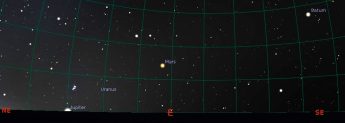This Week’s Sky at a Glance, 2024 June 15 – June 22
This Week’s Sky at a Glance, 2024 June 15 – June 22
Seasons are the result of the earth’s rotational axis being tilted about 23.5 degrees off the vertical, with respect to its orbit. The first day of astronomical summer is this Thursday. The “astronomical” qualification is used because meteorologists have taken to confusing people with meteorological seasons based on temperatures. Meteorological summer in the northern hemisphere includes June, July and August because they have the highest average temperatures for the year.
On the summer solstice, the Sun rises and sets at its most northerly points on the horizon. For those of us at 45 degrees latitude, at midday (1:20 pm in Moncton) the Sun is about 68.5 degrees above the southern horizon; its highest altitude for the year. If we lived at latitude 23.5 degrees the Sun would be directly overhead at midday on the solstice. Several millennia ago the Sun was “in” the constellation Cancer on the solstice, hence that latitude is marked on maps as the Tropic of Cancer. The dim constellation does resemble a crab somewhat, but there is speculation that the Sun’s forth and back movement along the horizon at that time of year was reminiscent of a crab’s sideways walk.
The summer solstice point on the ecliptic, the Sun’s path through the constellations, has since passed through Gemini into Taurus. The roaming solstice is due to Earth’s axis wobbling like a top, making one revolution every 25,800 years in what we call the precession of the equinoxes. Enjoy your summer, whenever it starts.
This Week in the Solar System
Saturday’s sunrise is at 5:35 and sunset will occur at 9:14, giving 15 hours, 39 minutes of daylight. Next Saturday the Sun will rise at 5:36 and set at 9:15, giving 15 hours, 39 minutes of daylight. The summer solstice occurs at 5:51 pm Thursday, with the Sun gracing our sky for the longest period of the year.
The Moon is near Spica on Sunday, near Antares Thursday, and it is full on Friday. If you are up with the robins at 4:30 am this weekend you can see Saturn one third of the way up in the southeast, Mars half as high in the east, and Jupiter just rising (binoculars will help) in the east-northeast. Mercury and Venus are lost in evening twilight this weekend but by next weekend Mercury sets 50 minutes after sunset and may be seen with binoculars. Castor and Pollux will be about two binocular widths above Mercury, and comet P13/Olbers might be visible about two binocular widths above them.
On Sunday evening at 8 pm, tune in to the Sunday Night Astronomy Show via the Facebook page or YouTube channel of Astronomy by the Bay.
Weekly Sky at a Glance ~by Curt Nason

